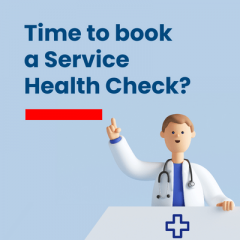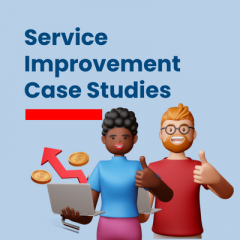
HM Land Registry is an organisation that is transforming the way it sees service management. This government department registers the ownership, interests and mortgages and other secured loans against land and property in England and Wales. It also holds one of the largest geospatial databases in Europe. HM Land Registry was also the very first organisation to become a member of the Service Desk Institute in 1989. We spoke to their IT service desk about their approach to Business Relationship Management (BRM) and their journey into agile ways of working.
HM Land Registry’s IT service desk supports over 5000 staff across 14 offices in England and Wales and they have been a member of SDI since 1989. Their external customers are primarily conveyancers, banks, lenders, solicitors, and property professionals. Citizens also used their public services last year, which include accessing property information and protecting your property from fraud.
Is Business Relationship Management a key part of your service desk strategy?
Relationship management is absolutely core to the way we work. We are ISO 20000 accredited and ITIL trained but BRM goes far beyond these processes. We want BRM to be front and centre as we move forward with an agile way of working and a renewed focus on engagement across our organisation and beyond.
Was there a turning point where you realised that you needed to work closer with the business?
We have a very high customer satisfaction rating within the HM Land Registry, usually around 99%. It would be easy to stay still and not push ourselves but we are an ambitious organisation and want to lead the way in service management.
Our internal IT development area moved to agile ways of working some years ago and are working in a DevOps environment. Agile has been a great success in these areas and we felt it was important to align ourselves with our IT colleagues. From a BRM perspective we have created service management cells. This revolutionary approach to service management enables us to focus on our stakeholders and customers to bring IT closer to the people who use it.
Before the explosion of web-based services, IT was almost like a back-office function, hidden away and no one really knew what we did. Now IT connects to our customers directly through us, offering services that are available on the web for them to interact with IT; it has now become a much more important and visible part of the business. We don’t think of ourselves as IT and the business, we are one organisation. That brings us a lot closer to the actual customers using the services.
We started a proof of concept in May 2017 and proved the concept with a pilot. We completed rolling out the brand new structure in February this year, and are now really seeing the results.
Could you explain what you mean by cell?
A cell is a small group comprised of different job roles focusing on services and customers, they work following Agile methodology. We looked initially at BRM, Service Level Management and the interaction with Service Level Agreements and that was the forming of the first cell. We are now integrating Problem Management and Change Management as well. Rather than having specialist silos like the change management team, the problem team etc., the cells manage all ITIL processes on behalf of a group of customers.
Focussing these groups of people on our customers and services means we have more in-depth knowledge of those services and customers and can build relationships a lot better. It is like becoming a specialist rather than a GP.
Outside of service management do you feed into or work with other areas of IT?
When a new service is being developed the cells get involved with development teams in the initial build and continue that relationship right through the alpha and beta stages and beyond. When services go-live the team understand the footfall and performance, it isn’t just about keeping the services running, there is also a clear focus on the customer experience.
It sounds like there’s a lot of cross-company communication. Did that require a culture shift?
HM Land Registry has launched a digital transformation and we have reorganised our IT department into Digital, Data and Technology (DDaT). We have a significant in-house Digital capability, and the new ways of working in this area have resulted in a significant shift to Agile. Our Service management community has identified a need to align to these new working practices, and to keep the two cultures working closely together.
We also see massive benefits in the Agile values, in that we seek to deliver value as early as possible in delivering change, avoid process for the sake of process, and great communications are the hallmark of success, rather than ticking a box in a process.
That sounds like a massive transformation. Did you have any resistance to this, from your customers, other business areas or your service management teams?
The organisation is right behind us. But whenever there has been any sort of major cultural or organisational change there is always a curve to go through and there have been some very valid concerns.
For example, problem management practitioners felt that their expertise is what drives the improvements in that area. They have a deep technical and process expertise and the feeling was that might be diluted by doing a load of other stuff as well. We didn’t want our problem management practitioners to be any less specialist or suddenly forget everything they knew, they’re picking up other skills as well – we’re encouraging the “T-Shaped” individual, with their existing expertise and specialist knowledge forming the stem of the “T” and the bit across the top is where we’re picking up knowledge and practitioner experience in other areas of service management.
Secondly, there has been a little bit of fear of the unknown and doing things differently has meant that we have engaged some external help in going through that process. We have an agile coach on board who is helping teams through their first week of forming a cell and we will be handholding as we continue to go through the transformation.
Apart from the coach have you had to try other methods to ease the transition for staff?
The first cell was built from volunteers who shared the same kind of fears but were very much behind this whole revolution. As part of the pilot we tried to openly show the transformation that we were going through and I can speak on behalf of the whole team that it was an enjoyable and enriching process. We have all come out of it the other side feeling a lot more committed to what we do on a day to day basis. We are making sure that it is as visible as it can be to the other teams before they embark on the process, which was part of what we were trying to do with the trial.
We have sent all the teams through the base camps, which is the first week of team forming. We saw some arms crossed for the first two days, some thoughtful expressions, and some resistance. but these changed to enthusiastic support for trying some new things, and a renewed team spirit towards the end of the week! It is key to develop the team spirit and enthusiasm for what you’re doing.
Have you noticed any immediate benefits from your agile journey, quick wins or efficiencies?
The most obvious benefit so far is the feedback from our stakeholders and the kind of relationships that we now have. They have fed back to say how much more involved they feel with what happens down here at the pointy end of IT. That has been really useful. Communication has improved by moving away from blanket emails to a route that our stakeholders want to use, such as Slack or WhatsApp… which makes everything more real-time and responsive.
The approach that we previously used to business relationships was waterfall; it was all focused around a service review meeting at the beginning of each month. Everything was saved up until then. We had a conversation with them for an hour, we gave them a document that, to be quite honest, not a lot of people read before the meeting, and that was ticked off as done. Now interaction is an everyday thing. We still do the formal meetings, but on the basis of a continually maintained relationship, and the information on the performance dashboard is in real-time. It is all there in self-service – there is no saving up to the end of the month, it is all available as soon as we know it. I think that has been a really good move.
Another benefit we have seen is that the more disciplines that we pull into the cell, the more we’re cutting out duplication that used to occur in the silos. I think when you are working on one aspect of service management you can become blinded to the fact that really that is just one piece of the jigsaw. Seeing the big picture, cutting down duplication, and having absolute ownership of things is very valuable.
All the innovation, the ideas and enthusiasm for getting stuff done is now coming from the teams. They know their customers really well, and so we’re happy to delegate innovation to them, and to self-manage what improvements they want to make. Clearly there is some strategic input, but the innovation is coming from within the teams and it is absolutely brilliant to see.
Have you learned any big lessons from your journey, and if others want to implement an agile way of working do you have any key tips for them?
We used an external coach and although they were absolutely a subject matter expert on agile ways of working, they also contributed massively from a personal development perspective and changing people’s mindsets.
What it boils down to is having a value compass, looking at what you do, looking at what you are trying to achieve and making sure what comes in between those things is the most efficient way of doing it. It is having that courage to try and break out of a mode that a lot of people have been in and question a lot of your everyday stuff to understand where the value is. Keep the value at the forefront of your mind and empower people because you can’t do anything without them.
It is a continual progress. We used to have an annual review of our improvement plan, the cycle is now daily. If you can progress and demonstrate progress every day you will see that you are doing the right things.
The one bit of advice for anyone thinking ‘how on earth do I get started?’ is: Learn about the agile principles and what you can take from that – if your people are working in a more agile way doing the same functions that they were before even that is of a benefit. It is not a framework, there isn’t a diagram that shows you how to do agile service management. It is applying agile principles to what you already do.
That’s a brilliant way to look at it. Is there anything you’d do differently?
We would want to do it quicker next time.
Do you think that would be possible?
Only a second time around. We spent a lot of time scratching our heads over how are we going to do this – we could have cut four or five months out by talking more efficiently and focusing more on the doing bit. The flipside of that is we have all had a lot more time to get used to the idea that things are going to change so in a way that has been beneficial, but knowing what we know now we could achieve the same thing quicker.
Have you implemented any new technologies as a result is becoming more agile?
We have introduced new ways of working. When the cells are forming, part of the agile coaching is going through the agile methodology ways of working, like Kanban, and we have also looked at Trello boards. But we are very much of the view that it is up to the cells how they want to work and how they manage themselves.
A lot of collaboration tools have surfaced through the use of Microsoft Teams and Trello. A member of the external service cell is a remote worker, hundreds of miles away. We have a live feed to him running on a desktop within the team so it is as if he is sat amongst us throughout the day. We are experimenting with these things, plus communicating through WhatsApp and Slack etc.
These productivity tools have helped us on our journey. We have also tried a few and not proceeded with them. I think in the old days we would have done an options paper, picked one and stuck at it no matter what. We used to say these are our technology tools of choice, whereas now we pick up and move on much faster – for instance, how quickly did we implement WhatsApp? We implemented it during the middle of a major service disruption because we saw the value in doing so and it was very quick and easy – these tools are much quicker and easier to adopt these days.
Do you have any performance measures attached to this? Is there anything that you’re looking specifically to achieve?
We have four ambitions.
- First is to be world-class for speed, responsiveness and agility, and I guess that will come in the form of external recognition if that happens but it is not the end of the world if it doesn’t.
- The second is to love what we do and that will be reflected in our employee engagement statistics. There is an online civil service survey, every time we complete it we look eagerly to see what the results are.
- Third is for our customers to feel that their views are listened to and acted upon, and that comes through feedback. We are trying to blend Agile with ISO 20000 and ITIL picking out the parts which add the most value.
- Fourth, is to Enable Change; this relates to making sure our Digital Services have a smooth passage into general use, but also to make sure we help our technology colleagues achieve their aim of a continuous release velocity.
Lastly, what does being agile mean to you?
We see Agile in the service management world as slightly different from the Agile development of new services, but many of the principles apply.
- We value a great customer relationship and experience more than a watertight SLA
- We value our people being responsive and able to change quickly to deal with the unexpected rather than pushing something down a well-trodden process path
- We value doing the right thing more than writing about how we will follow a process
- We value trying new ways of getting things done, more than we value extensive planning, but we want to know as soon as possible if it’s not working
Land Registry was the first-ever company to join the Service Desk Institute, being loyal members since 1989. Find out more about SDI Membership by visiting our website today.























